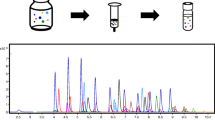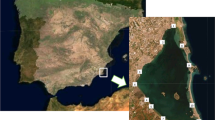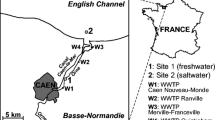Abstract
This study validated the analysis of organochlorine pesticides (OCPs) in shellfish and cephalopods using a gas chromatograph equipped with a mass spectrometry (GC–MS/MS), and monitored residual pesticide levels. The QuEChERS method was used to analyze OCPs and was validated by checking the linearity, limit of detection (LOD), limit of quantitation (LOQ), accuracy, and precision. Octopus minor and Venerupis philippinarum, were purchased from four cities in the South Korean peninsula. The LOD values were 0.10–0.80 ng/g in shellfish and 0.21–0.77 ng/g in cephalopods, while the LOQ values were 0.31–2.41 ng/g in shellfish and 0.63–2.33 ng/g in cephalopods. Accuracy ranged from 83.5 to 117.4% and 79.8 to 118.4%, and precision ranged from 0.3 to 27.5% and 1.2 to 27.9%, in shellfish and cephalopods, respectively, conforming to the Codex Alimentarius Commission guidelines. Although residual OCP levels were below detection limits, the QuEChERS method may be effective for analyzing the OCPs in shellfish and cephalopods.


Similar content being viewed by others
References
Anastassiades M, Lehotay SJ, Štajnbaher D, Schenck FJ. Fast and easy multiresidue method employing acetonitrile extraction/partitioning and “dispersive solid-phase extraction” for the determination of pesticide residues in produce. J. AOAC Int. 86: 412-431 (2003).
Boonyatumanond R, Jaksakul A, Puncharoen P, Tabucanon MS. Monitoring of organochlorine pesticides residues in green mussels (Perna viridis) from the coastal area of Thailand. Environ. Pollut. 119: 245-252 (2002).
Buah-Kwofie A, Humphries MS. Validation of a modified QuEChERS method for the analysis of organochlorine pesticides in fatty biological tissues using two-dimensional gas chromatography. J. Chromatogr. B 1105: 85-92 (2019).
Choi J-Y, Lee S-G, Bang J-H, Yang D-B, Hong G-H, Shin K-H. On the distribution of PCBs and organochlorine pesticides in fish and sediment of the Asan Bay. Ocean Polar Res. 33: 45-53 (2011).
Choi JY, Yang D-B, Hong G-H, Kim SH, Chung CS, Kim K-R, Cho KD. Potential human risk assessment of PCBs and OCPs in edible fish collected from the offshore of Busan. J. Korean Soc. Environ. Eng. 34: 810-820 (2012).
Chun OK, Kang HG. Estimation of risks of pesticide exposure, by food intake, to Koreans. Food Chem. Toxicol. 41: 1063-1076 (2003).
Chung SW, Chen BL. Determination of organochlorine pesticide residues in fatty foods: A critical review on the analytical methods and their testing capabilities. J. Chromatogr. A 1218: 5555-5567 (2011).
Codex Alimentarius Commission. Guidelines on good laboratory practice in residue analysis. CAC/GL 40 (2003).
Dirbaba NB, Li S, Wu H, Yan X, Wang J. Organochlorine pesticides, polybrominated diphenyl ethers and polychlorinated biphenyls in surficial sediments of the Awash River Basin, Ethiopia. PLoS One 13: e0205026 (2018).
Food and Agriculture Organization of the United Nations. The state of world fisheries and agriculture (2016) Available from: http://www.fao.org/3/a-i5555e.pdf. Accessed Nov. 31, 2019.
Giandomenico S, Spada L, Annicchiarico C, Assennato G, Cardellicchio N, Ungaro N, Di Leo A. Chlorinated compounds and polybrominated diphenyl ethers (PBDEs) in mussels (Mytilus galloprovincialis) collected from Apulia Region coasts. Mar. Pollut. Bull. 73: 243-251 (2013).
Guruge K, Tanabe S. Contamination by persistent organochlorines and butyltin compounds in the west coast of Sri Lanka. Mar. Pollut. Bull. 42: 179-186 (2001).
Hajšlová J, Zrostlíková J. Matrix effects in (ultra) trace analysis of pesticide residues in food and biotic matrices. J. Chromatogr. A 1000: 181-197 (2003).
Hu G, Dai J, Mai B, Luo X, Cao H, Wang J, Li F, Xu M. Concentrations and accumulation features of organochlorine pesticides in the Baiyangdian Lake freshwater food web of North China. Arch. Environ. Contam. Toxicol. 58: 700-710 (2010).
Lee M-G, Lee S-R. Monitoring efficiency on pesticide residues in Korean foods. Food Sci. Biotechnol. 10: 188-192 (2001).
Lehotay SJ, Son KA, Kwon H, Koesukwiwat U, Fu W, Mastovska K, Hoh E, Leepipatpiboon N. Comparison of QuEChERS sample preparation methods for the analysis of pesticide residues in fruits and vegetables. J. Chromatogr. A 1217: 2548-2560 (2010).
Liu Z, Zhang H, Tao M, Yang S, Wang L, Liu Y, Ma D, He Z. Organochlorine pesticides in consumer fish and mollusks of Liaoning Province, China: distribution and human exposure implications. Arch. Environ. Contam. Toxicol. 59: 444-453 (2010).
Monirith I, Ueno D, Takahashi S, Nakata H, Sudaryanto A, Subramanian A, Karuppiah S, Ismail A, Muchtar M, Zheng J. Asia-Pacific mussel watch: monitoring contamination of persistent organochlorine compounds in coastal waters of Asian countries. Mar. Pollut. Bull. 46: 281-300 (2003).
Norli HR, Christiansen A, Deribe E. Application of QuEChERS method for extraction of selected persistent organic pollutants in fish tissue and analysis by gas chromatography mass spectrometry. J. Chromatogr. A 1218: 7234-7241 (2011).
Osibanjo O, Bamgbose O. Chlorinated hydrocarbons in marine fish and shellfish of Nigeria. Mar. Pollut. Bull. 21: 581-586 (1990).
Salem DMA, El Sikaily A, El Nemr A. Organochlorines and their risk in marine shellfish collected from the Mediterranean coast, Egypt. Egypt. J. Aquat. Res. 40: 93-101 (2014).
Santana-Mayor Á, Socas-Rodríguez B, Herrera-Herrera AV, Rodríguez-Delgado MÁ. Current trends in QuEChERS method. A versatile procedure for food, environmental and biological analysis. TrAC-Trends Anal Chem 116: 214-235 (2019).
Santhi V, Hairin T, Mustafa A. Simultaneous determination of organochlorine pesticides and bisphenol A in edible marine biota by GC–MS. Chemosphere 86: 1066-1071 (2012).
Sun F, Wong S, Li G, Chen S. A preliminary assessment of consumer’s exposure to pesticide residues in fisheries products. Chemosphere 62: 674-680 (2006).
Takeuchi I, Miyoshi N, Mizukawa K, Takada H, Ikemoto T, Omori K, Tsuchiya K. Biomagnification profiles of polycyclic aromatic hydrocarbons, alkylphenols and polychlorinated biphenyls in Tokyo Bay elucidated by δ13C and δ15N isotope ratios as guides to trophic web structure. Mar. Pollut. Bull. 58: 663-671 (2009).
WHO. Endrin health and safety guide. World Health Organization (1991).
Wilkowska A, Biziuk M. Determination of pesticide residues in food matrices using the QuEChERS methodology. Food Chem. 125: 803-812 (2011).
Wu Y, Zhang J, Zhou Q. Persistent organochlorine residues in sediments from Chinese river/estuary systems. Environ. Pollut. 105: 143-150 (1999).
Yang N, Matsuda M, Kawano M, Wakimoto T. PCBs and organochlorine pesticides (OCPs) in edible fish and shellfish from China. Chemosphere 63: 1342-1352 (2006).
Yim U, Hong S, Shim W, Oh J. Levels of persistent organochlorine contaminants in fish from Korea and their potential health risk. Arch. Environ. Contam. Toxicol. 48: 358-366 (2005).
Zacharewski T. Identification and assessment of endocrine disruptors: limitations of in vivo and in vitro assays. Environ. Health Perspect. 106: 577-582 (1998).
Zhou J, Maskaoui K, Qiu Y, Hong H, Wang Z. Polychlorinated biphenyl congeners and organochlorine insecticides in the water column and sediments of Daya Bay, China. Environ. Pollut. 113: 373-384 (2001).
Zhou R, Zhu L, Kong Q. Levels and distribution of organochlorine pesticides in shellfish from Qiantang River, China. J. Hazard. Mater. 152: 1192-1200 (2008).
Acknowledgements
This research was supported by the Grant (16162 MFDS 607) from Ministry of Food and Drug Safety and Chung-Ang University Graduate Research Scholarship in 2018.
Author information
Authors and Affiliations
Corresponding author
Ethics declarations
Conflicts of interest
The authors declare that they have no conflict of interest.
Additional information
Publisher's Note
Springer Nature remains neutral with regard to jurisdictional claims in published maps and institutional affiliations.
Rights and permissions
About this article
Cite this article
Hwang, SM., Lee, HU., Kim, JB. et al. Validation of analytical methods for organochlorine pesticide detection in shellfish and cephalopods by GC–MS/MS. Food Sci Biotechnol 29, 1053–1062 (2020). https://doi.org/10.1007/s10068-020-00748-0
Received:
Revised:
Accepted:
Published:
Issue Date:
DOI: https://doi.org/10.1007/s10068-020-00748-0




